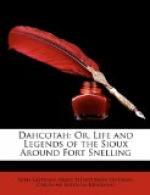Famine now showed itself among them. They had neither corn nor flour. Had the wild ducks flown over their heads in clouds, there was but little powder and shot to kill them—but there were few to be seen. Some of the Indians proposed moving their camp where game was more plenty—where they might see deer, and use their bows and arrows to some purpose. But others said, if they were not at the appointed place of meeting, they would violate the contract, and lose their claim to the articles that Hole-in-the-day had promised to deliver to them.
It was finally concluded that the party should divide, one half moving off in search of food, the other half remaining where they were, in hopes that Hole-in-the-Day would make his appearance.
Three teepees then remained, and they were occupied by seventeen persons, all women and children excepting four. It was drawing on towards evening, when the Dahcotahs heard the sound of footsteps, and their satisfaction was very great, when they perceived the Chippeway chief approach, accompanied by ten of his men. These men had been present at the council of peace in February.
One of the Dahcotahs, named Red Face, had left his family in the morning, to attend to the traps he had set for beaver. He had not returned when the Chippeways arrived. His two wives were with the Dahcotahs who received the Chippeways. One of these women had two children; the other was quite young, and, according to Indian ideas, beautiful too. She was the favorite wife.
The Dahcotahs received the Chippeways with real pleasure, in full faith and confidence. “Hole-in-the-Day has been long in coming,” said one of the Dahcotahs; “his friends have wished to smoke the pipe of peace with him, but some of them have left us to seek for food. We welcome you, and will eat together, and our friendship shall last forever.” Hole-in-the-Day met his advances with every appearance of cordiality. One thing, however, the Dahcotahs observed, that the Chippeways did not fire their guns off when they arrived, which is done by Indians when they make a visit of friendship.
The party passed the evening in conversation. All the provisions of the Dahcotahs were called in requisition to feast the Chippeways. After eating, the pipe went round again, and at a late hour they laid down to sleep, the Chippeways dividing their party, several in each teepee.
Hole-in-the-day lay down by the side of his host, so motionless you would have thought that sleep had paralyzed his limbs and senses; his regular breathing intimates a heart at peace with himself and his foes; but that heart was beating fast, for in a moment he raises himself cautiously, gazes and smiles too upon the sleeping Dahcotah beside him. He gives the appointed signal, and instantaneously plunges his knife into the heart of the trusting Dahcotah. It was child’s play afterwards to quiet the shrill shrieks of the terrified wife. A moment more, and she and her child lay side by side, never to awake again.




